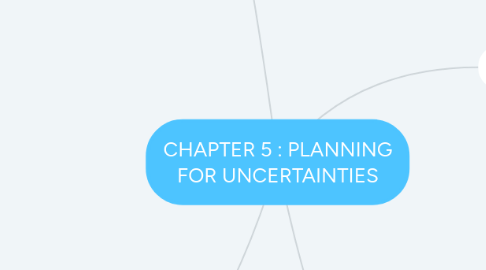
1. TYPES OF INSURANCE
1.1. Insurance is classified into Life and General
1.2. LIFE INSURANCE
1.2.1. Insures against risks such as premature death, illness,disability and hospitalization
1.2.2. Coverage is more than a year
1.2.3. Premium payments – monthly, quarterly, semi-annually or annually
1.2.4. TYPES OF LIFE INSURANCE
1.2.4.1. Term insurance
1.2.4.1.1. most basic, generally least expensive -under age 50
1.2.4.1.2. typically 1 to 10 years, may be renewable at the end of each term
1.2.4.1.3. benefit is payable only if the insured dies/become totally & permanently disable during the policy term
1.2.4.2. Whole Life
1.2.4.2.1. combines permanent protection with a savings component. - Part of premium accrues as cash value
1.2.4.2.2. As the policy gains value, you may be able to borrow up to 90% of your policy's cash value tax-free
1.2.4.2.3. The proceeds of this plan are payable when premature death occurs or the policy matures
1.2.4.3. Endowment
1.2.4.3.1. Combines protection and savings.
1.2.4.3.2. Provides cash benefits at the end of a specific period or upon death or total and permanent disability during the same period.
1.2.4.4. Investment – linked
1.2.4.4.1. Combines investment and protection.
1.2.4.4.2. Get to choose the type of investment fund – stock, bond or money market funding options and the amount of life insurance coverage.
1.2.4.5. Medical & heath
1.2.4.5.1. cover the cost of medical treatment – hospitalization & surgery
1.2.4.6. Mortgage Reducing Term Assurance (MRTA)
1.2.4.6.1. Single premium policy with coverage amount matching the scheduled outstanding balance of the loan
1.2.4.6.2. Settle the loan if default due to illness or disability or premature death
1.2.4.6.3. Ownership to borrower or beneficiaries
2. GENERAL INSURANCE
2.1. Any insurance other than human lives comes under the scope of General Insurance
2.2. It is preferable to call this as General Insurance instead of non-life insurance
2.2.1. Motor
2.2.2. House
2.2.3. Travel
2.2.4. Personal belonging
2.3. TAKAFUL
2.3.1. Development of Takaful – Malaysia Case Study
2.3.1.1. Takaful industry is relatively new compared to conventional insurance companies in Malaysia.
2.3.1.2. The National Fatwa Committee of the Malaysian Islamic Affairs Council declared the conventional life insurance business contradicted with Islamic principles in 1972.
2.3.1.3. In 1985, the Fiqh Academy of the OIC made a declaration that all forms of conventional insurance do not conform with Islamic principles
2.3.2. Development of Takaful – Malaysia Case Study
2.3.2.1. Takaful Act 1984 was introduced to supervise the takaful activities since Insurance Act could not be applied to the takaful business in Malaysia.
2.3.2.2. Takaful Malaysia Sdn. Bhd. was established in 1984 with paid-up capital of RM10 Million and there are four takaful operators in Malaysia.
2.3.2.3. Currently there are 11 takaful operators and 4 retakaful operators in Malaysia
2.3.3. Basic Concepts of Takaful
2.3.3.1. Al-Mudharabah – means ‘profit sharing’. The takaful operator accepts and invests the takaful contributions (Premiums) received from the takaful participants. The contract will specify how the profit will be shared between the participants and takaful operator.
2.3.3.2. Al-Takaful – means joint guarantee whereby the participants jointly guarantee amongst themselves. Any member faced with a calamity will be financially compensated from funds contributed by the participants.
2.3.3.3. Tabarru – refers to elements of ‘donation’. Each participant agrees to relinquish a portion of the takaful contribution to a common fund that is used to pay a member that suffers a loss.
2.3.4. TAKAFUL
2.3.4.1. Family Takaful
2.3.4.1.1. The plans available is quite similar to the endowment policy in conventional life insurance practice where participants may choose a fixed period of coverage. Installment payment can be in Participants Account (PA) and Participant Special Account (PSA).
2.3.4.2. General Takaful
2.3.4.2.1. The protection on short term basis. The participants’ contribution is wholly on tabarru (donation) basis and sharing of profits is on underwriting surplus and investment income. Surplus is derived after deducting company’s expenses from this fund.
3. WHAT IS INSURANCE?
3.1. Insurance is a legal contract that transfers risk from a policyholder to an insurance provider
3.2. WHY YOU NEED INSURANCE
3.2.1. Protection against loss due to hazard and unexpected events
3.2.2. Compensation for damages for personal belongings
3.2.3. Increased Medical Bills
3.2.4. Living expenses in disability or serious illness
3.3. HOW DOES INSURANCE WORK
3.3.1. Insurance company pay for damages due to insured peril up to the limit of sum insured
3.3.2. Insurance company sells policies to many people and pool the premium collected into a common fund.
3.3.3. The common fund helps to share risks
4. WHY IS RISK IMPORTANT FOR INSURANCE
4.1. Risk is what makes you decide whether or not you need insurance.
4.2. Risk is what insurance companies measure when determining whether to offer you insurance and how much it will cost.
4.3. HOW DO WE HANDLE RISK
4.3.1. Avoidance
4.3.1.1. Choosing not to participate in an activity because of the risk involved,
4.3.1.2. Exple : not getting a driver’s license, not going for holiday etc;
4.3.2. Retention
4.3.2.1. Saving money in case of future losses,
4.3.2.2. Exple : putting RM1K in a savings account in case of a car accident
4.3.3. Transfer
4.3.3.1. Passing the risk on to an insurance company,
4.3.3.2. Exple : paying a premium fee for an insurance policy and expecting the insurance company to protect your assets
